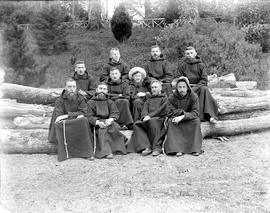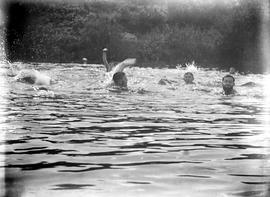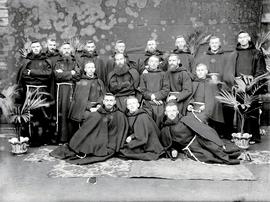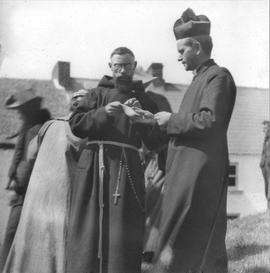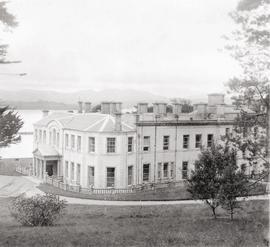The collection comprises over 300 original glass plate negatives and lantern slides. Prior to the invention of cellulose nitrate film in 1903, photographic emulsions were made on glass supports. These glass supports are typically referred to as glass plate negatives. The term ‘glass plate negative’ refers to two separate formats: the collodion wet plate negative and the gelatin dry plate. Both formats consist of a light sensitive emulsion that is fixed to the glass plate base with a binder. This form of photographic process largely faded from the consumer market in the early years of the twentieth century, as more convenient and less fragile films were introduced. Despite the impracticalities of the medium, glass negative plates were generally considered superior to cellulose nitrate film for high-quality imaging because they were extremely stable and less likely to bend or distort.
The collection also includes several lantern slides. Lantern slides were constructed from a base piece of glass, with the emulsion (carrying the photo or print) on it, then a matte over that, and then a top piece of cover glass. They were then taped all the way around to keep the pieces together and to keep dust out. Occasionally, colour was added by hand, tinting the images (these lantern slides were created before the invention of colour film). The slides were then projected onto a screen using a bespoke lantern slide projector. Lantern glass slides were used by some public speakers until the mid-twentieth century, when they were eclipsed by more economical and practical 35mm colour slides popularised by Kodachrome. Finally, the collection also includes some original glass stereo plates. Stereo cameras used a single glass plate negative to capture images. Prints from these negatives were intended to be looked at with a special viewer called a stereoscope, which created a rudimentary three-dimensional image.
Provenance and Collection Content
Precise information on the provenance of the collection is lacking. The plates were retrieved from a worn leather suitcase bearing the initials ‘F.A.’ which almost certainly refers to Fr. Angelus Healy OFM Cap. (1875-1953). Although Fr. Angelus never considered himself an academic historian, he researched assiduously and transcribed many original documents relating to the history of the Irish Capuchins. His ‘Pages from the Story of the Irish Capuchins’ was published in 1915 to mark the tercentenary of the arrival of the first Capuchin friar in Ireland. It is highly likely that Fr. Angelus was responsible for assembling this glass plate photographic collection and that many of the lantern slides were created specifically for his use.
The image content of the glass plate collection is eclectic and varied. Only a relatively small number of the images are dated but it can be inferred that most of the photographs date to the first or second decade of the twentieth century. Many of the plates show images of scenes around the Capuchin Friary in Rochestown in County Cork. The Capuchins established a community in Rochestown, situated about five miles from Cork city, in 1873. The Irish friars had founded a Seraphic School in 1884 with the primary aim of training young religious. This school originally operated along the lines of a novitiate for students who aspired to join the Capuchin Franciscan Order. In 1887, this school was transferred from Kilkenny to Rochestown. The collection includes many images of novice friars and students attached to the Rochestown house. In addition to photographs of the friary itself, local landmarks, buildings, and scenic locations in the environs of Rochestown feature prominently in some of the images. Several photographs showing other Irish Capuchin houses and foundations such as the Church of St. Francis in Kilkenny are also extant in the collection. The collection also includes some rare images of the Reek Sunday pilgrimage to the summit of Croagh Patrick in County Mayo (CA-PH-1-49-55). The 764-metre-high mountain is traditionally climbed by pilgrims on the last Sunday in July. These images were likely assembled by Fr. Angelus Healy OFM Cap., who was known as the ‘Guardian of the Reek’ in honour of his long association with the pilgrimage. His association with Croagh Patrick lasted from 1906 to 1949, during which he climbed the mountain forty-two times missing only two years, in 1919 due to a railway strike, and in 1922 due to the Civil War.
A seemingly separate series of lantern slides relating to the life and career of Fr. Theobald Mathew OSFC (1790-1856), a famed nineteenth century temperance campaigner and Capuchin friar, were also deposited in the collection. It is very probable that these slides were used as illustrative aids by the Capuchins for public talks and auditorium lectures on Fr. Mathew’s campaign against intoxicating liquor. Temperance activity was revived in 1905 when the Irish Catholic hierarchy invited the Capuchins to preach a National Crusade. This revival initially elicited widespread public enthusiasm and by 1912 the Capuchins had administered over a million pledges throughout the country. The lanterns slides were, in all probability, used in this campaign. Finally, the collection also includes images of seventeenth century manuscripts and photographs of other original records pertaining to the lives and ministries of several early Irish Capuchins. These were probably acquired by Fr. Angelus Healy OFM Cap. and Fr. Stanislaus Kavanagh OFM Cap. (1876-1965), another prominent Irish Capuchin historian, for research purposes.

